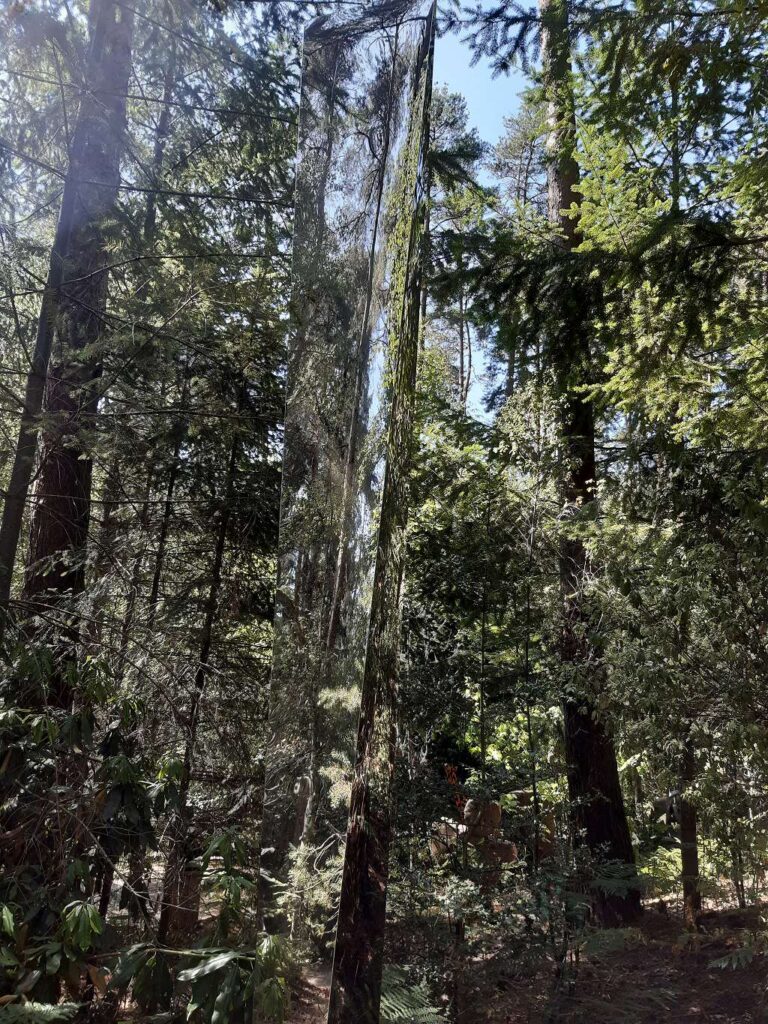
Mirror Shard in Farnham Sculpture Park


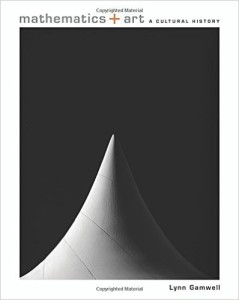
Lynn Gamwell’s Mathematics + Art, A Cultural History (Princeton, 2016) is a beautiful, magnificent, and rather large book. Given its size, its cover price ($50) is very reasonable. The topic is an enormous one, ranging from the ancient to the ultra-modern.
Gamwell makes a serious attempt to cover the ground comprehensively. The book begins with Arithmetic and Geometry (two huge areas in themselves), and a glorious image from a Bible moralisée of 1208-1215 of God the Geometer, measuring out the world – it looks rather like a geode in section, actually – with a pair of dividers.
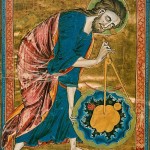
Page 1 mentions “Mankind’s ape-like ancestors” and talks about the first symmetrical tools; 300,000 years ago, hand axes started to have elegant symmetry. Clearly Gamwell’s intention is to cover the interaction of mathematics + art in the whole span of human history and prehistory: it’s nothing if not ambitious.
The text sweeps rapidly through time, so that on page 3 we reach 3000 BC and the ancient foundations of recorded mathematics, with I, II, III tracking quantities; the Egyptians introduced ∩ for 10, so 12 was ||∩. Soon we are in Ancient Greece and the theorems of Thales (the base angles of an isosceles triangle are equal…), and what the sculptor Polykleitos wrote about the perfect proportions of the human body in the 5th century BC. Attention switches to the elements and the Platonic solids (with a forward reference to Kepler’s depiction in Harmonices Mundi, 1619), Democritus’s mechanical universe, and Euclid’s Elements – all in the first chapter, and I haven’t even mentioned the detailed treatment of the birth of modern physics and Newton’s law of universal gravitation, which Gamwell actually explains with the famous inverse square law equation.

The book, in other words, is big, and dares to boldly go where others fear to tread (Steven Hawking wrote in his A Brief History of Time that each equation halved the number of readers: Gamwell has plenty, and explains the symbols of formal logic, too.) She can cover the plans of Gothic cathedrals, the mysteries of perspective from the Italian Renaissance, Zeno’s Paradox (can Achilles catch that tortoise?), modern art from Mondrian to Henry Moore, Bauhaus to Bourbaki. It’s kaleidoscopic, and if you wanted a coffee-table book then you could just flick through it and enjoy the Mandelbrot and Julia sets, gloriously illustrated.
But of course readers expect and deserve more. The chapters cover Arithmetic and Geometry; Proportion; Infinity; Formalism; Logic; Intuitionism; Symmetry; Utopian visions after World War I; The Incompleteness of Mathematics; Computation; Geometric Abstraction after World War II; Computers in Mathematics and Art; and Platonism in the Postmodern Era. This is visibly a huge scope – all of mathematics, all of art, and all of their intersection (to coin a phrase from set theory).
But wait a minute: all of art? It’s certainly all of the time during which art has been created, bone flute (Hohle Fels cave, c. 42,000 years ago) and Lascaux cave paintings (ca 15,000 BC) included. The discussion of art cheerfully scoots about from Iceland to Renaissance Italy; from Russia to China to Japan; from a Hungarian-born Argentine artiss (Gyula Kosice) to the American hand-blown glass and steel sculptures of Josiah McElheny. The reader grapples with fractals and their recursive algorithms; formalist mathematics and constructivism; Klein bottles and the odd behaviour of electrons in quantum mechanics. Gödel, Escher and Bach do their Hofstadter-esque dance of self-reference.
The Elephant in the Room
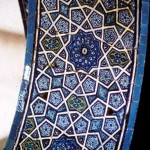
So what is missing? The 556 pages barely so much as blink in the direction of Islamic Art, of the dazzling complexity and virtuosity of its geometric designs and decorations, of its centuries-long contribution to mathematics – even the words algorithm and algebra come from Al-Khwarizmi’s name and his book of pioneering mathematics. Nothing. Zilch. Nix. Or as the Arabs would say, Zifr. Well, they invented it.
Did Gamwell simply not know about Islamic tessellations? Of Escher’s inspiration in the Alhambra? Of Girih strapwork all over the minbar pulpits of Egypt, all over the turquoise domes of Persia? Of the dazzling Zellige tilework of Morocco? Of the lustre tiles of Tunisia? Of the inlaid geometric stonework of the Umayyad Mosque in Damascus? Of the airy Jali stone screens of the Mughal palaces of India? It seems not. Her index includes “Arabic numerals”, but she did not follow up that broad clue.
Gamwell has written a fascinating, beautiful, intriguing, and stimulating book. It is sometimes rather too academically picky; sometimes a bit too thorough in explanation, but then you may need more than me on some topics. It is perhaps a bit too much focussed on the twentieth century – after all, why that century, not all the others? Recentism is no reliable guide. But the glaring gap, or as a pretentious art critic would say, the lacuna of all lacunae, is the extraordinary lack of coverage of the whole of the Islamic world. Try a look in the Index – you won’t find Arabia (apart from Arabic numerals), or Morocco, or Syria, or Iran (or even Persia), or Moghul/Mughal. It’s just not there.
I think this matters, and matters terribly. If George Bush and Tony Blair had it in their blood that art, science, mathematics, medicine, poetry, music, pottery, metalwork, masonry, glass, carpets, and gardens all flourished in the Islamic world, for century after century, from the Moroccan Maghreb (“The West”) to Turkey, Egypt, Persia, Afghanistan, all of the Indian subcontinent, Indonesia – would they have acted as ignorantly as they did? And more importantly now, will our future leaders be any better informed, or will they treat Sunni and Shia alike as ignorant savages? For what it’s worth, Daesh / ISIS / ISIL is not Islam, it’s a stupid and wicked splinter group, and has nothing whatsoever to do with a great cultural heritage. Especially, it should not colour our attitudes to Muslims and Islam.
Some of the white space in Mathematics + Art can be filled by other books, such as Luca Mozzati’s Islamic Art, or Eric Broug’s Islamic Geometric Designs.
All the same, I felt sufficiently engaged at the lack of coverage to do something about it. I brought two Wikipedia articles, Mathematics and art, and Islamic geometric patterns, to “Good Article” status, pretty much rewriting them from scratch in the process. To make the whole area a bit easier to navigate, I also rewrote the navigation template on Islamic art. Together, these are seen – and perhaps read – by around 100,000 people a year, and of course they help to inform blogs and social media postings, so maybe they will have some effect. If you can suggest ways of reaching more people with this sort of knowledge, I’d be happy to hear from you.
The artist Gail Dickerson creates her paintings through what must be a unique combination of observation of technological artefacts and the deliberate application of natural materials through the recreation of natural processes.
Thus it is no accident that her paintings have a natural, accidental, chaotic look: they are created from actual earths, muds and clays of many different colours – real earth pigments – and they are allowed to form themselves on to the canvas through processes that recreate the basic geological processes of erosion (of rocks) and deposition (of sediments). Gail crushes and grinds the earths to form usable pigments: of course she also transports them to her studio, just as glaciers transport rocks as ‘erratics’, grind and crush rocks to rock-flour as moraines and the thick, sticky boulder clay that covers the little hills of Southeast England.
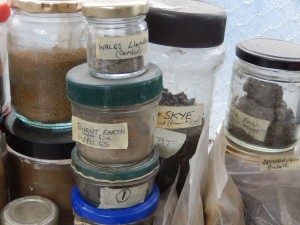
Then she mixes the pigments with water and a binder to make simple paints, and pours them on to her canvases, where they flow, evaporate, diffuse, and arrange themselves into the beautiful fractal patterns of sand-dunes, beach ripples, estuary channels, or just puddles seen in her paintings.
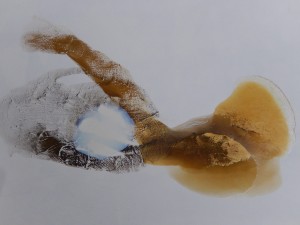
The other input to Gail’s paintings is the high-speed world of modern technology. She strips printed circuit boards from abandoned devices (which with today’s instant obsolescence often means only a couple of years after they were made) and draws their patterns on to her canvases. In an earlier phase of her work, she actually placed assorted components on the canvas and allowed them to leave their “shadows” behind as pigments flowed over and around them.
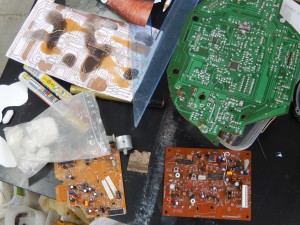
Circuit boards form patterns as their wiring is optimised to follow shortest paths for the many interconnections, as well, sometimes, as to provide sufficient spacing to reduce electromagnetic interference between the rapidly oscillating currents in the tiny wires. (Gail commented that these technical terms would make good names for artworks.) Gail had redrawn or imagined suitable wiring layouts on transparencies, and it was hard to tell her imaginings from the real thing, so convincingly did they wander in apparently optimal directions between components.
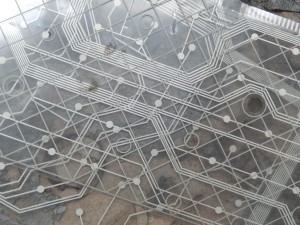
Gail then transfers the circuit layouts, suitably transformed, to her canvases, where they and the variously oozing, evaporating earths in their chaotic patterns do a dance together, neither taking over, neither too prominent.
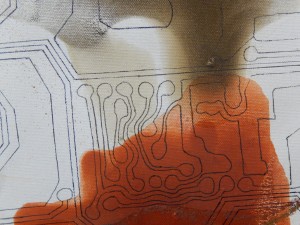
For me, it’s a figure of the modern world, where man makes use of nature – ColTan ore turning into electronic components, sand turning into silicon chips, oil turning into the plastics and resins of insulation and circuit boards (after all, all materials are ultimately from nature), and the manmade patterns of thought, algorithmically-designed electronics, squeak and chatter at their inaudibly-high GigaHertz frequencies (as recently as 1994, we all had slow old modems that audibly squeaked when connecting to the Internet to retrieve emails and briefly browse a few small klunkily laid out early web pages, how quickly things change in that world).
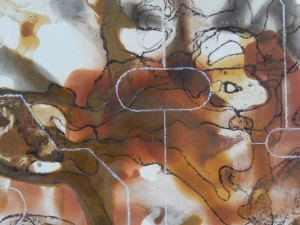
For me, then, Gail’s paintings, made in nice old buildings a stone’s throw from the Shard, the river, and Shakespeare’s Globe – inevitably, just about to be turned into expensive new apartments or offices – beautifully sum up modern life. We are still rooted in Nature: our tailless ape ancestry of course, our drives for food, water, sex, power, sleep absolutely apelike; while another part of us races ahead in the bustling city, now sprawling across the river from the City of London to the Docklands and down onto the South Bank around London Bridge and the suddenly burgeoning glass towers of Southwark. Alexander Pope had it right in his Essay on Man when he describes us as
Created half to rise and half to fall,
The glory, jest, and riddle of the world.